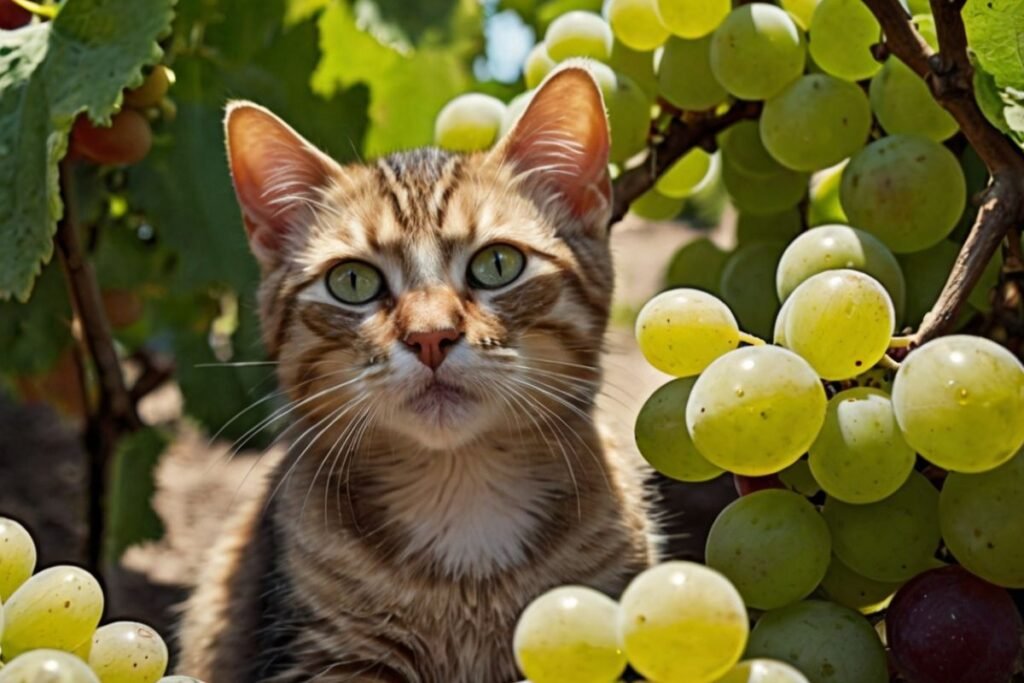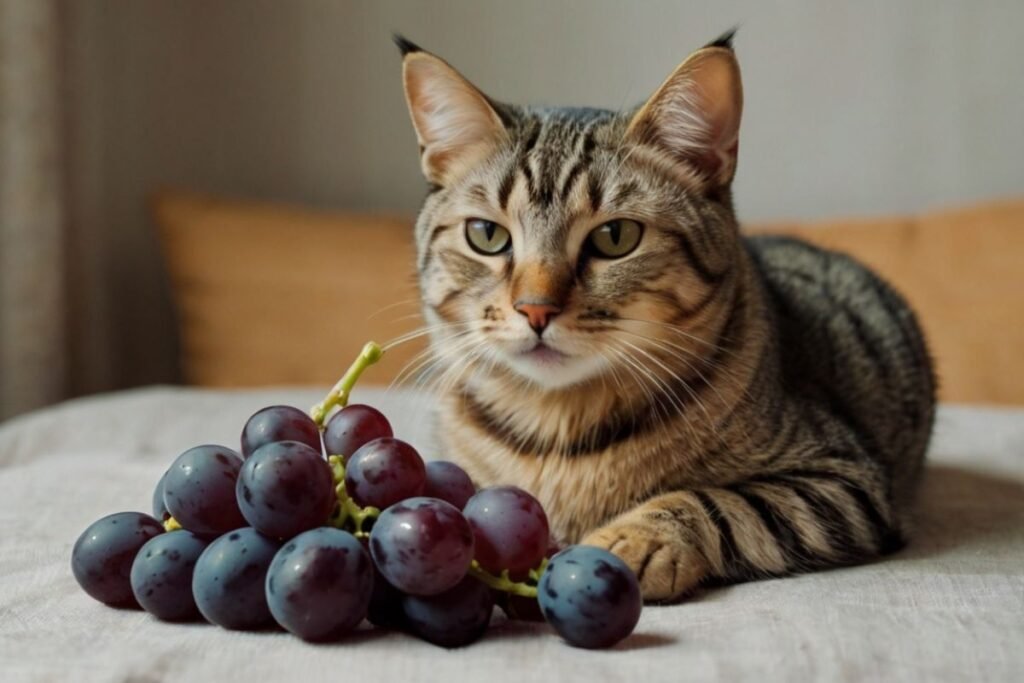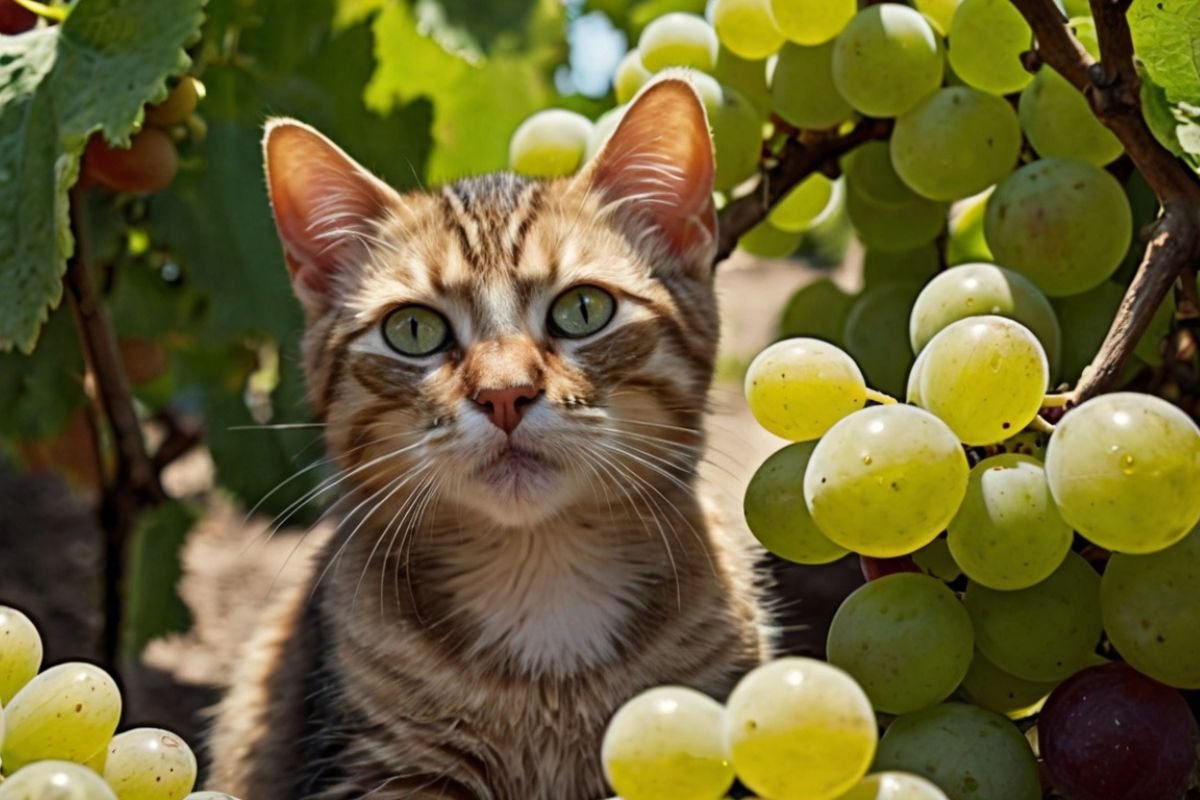Have you ever been snacking on some juicy grapes and noticed your cat’s curious eyes fixed on your food? Those little paws might reach out, trying to grab what you’re enjoying. It’s a scene many cat owners know well. But should you share?
The short answer is no. Grapes are not safe for cats.
But why? What happens if your cat eats grapes? And what should you do if your feline friend has already munched on this forbidden fruit?
As a cat parent to Rio, my playful two-year-old orange tabby, I’ve learned that what’s harmless to us can be deadly to our pets. That’s why I’ve put together this complete guide about cats and grapes.
Let’s dive into this important topic to keep our furry family members safe and healthy.

Table of Contents
Are Grapes Toxic to Cats?
Yes, grapes are toxic to cats. Both grapes and raisins (dried grapes) can cause serious health issues in cats, even in small amounts.
This isn’t just a mild warning. Grape toxicity in cats is a real and serious concern. The scary part? Vets and animal experts still don’t fully know what makes grapes toxic to cats. The exact substance that causes the toxic reaction remains a mystery.
What we do know is that grapes can cause acute kidney failure in cats. This is not a risk worth taking.
Also read, Can Cats Eat Bread?
Why Are Grapes Bad for Cats?
Scientists aren’t 100% sure what makes grapes toxic to cats. Some think it might be a substance called tartaric acid. Others point to a compound known as pthalide. But the truth is, we still don’t have a clear answer.
What makes this even more tricky is that not all cats react the same way to grapes. Some cats might eat a grape and seem fine. Others might get very sick from just a tiny bit.
This unpredictable nature makes grapes even more dangerous. You simply can’t know how your cat will react.
Last summer, Rio knocked over a bowl of grapes on our kitchen counter. I caught him before he ate any, but my heart raced thinking about what could have happened. That’s when I decided to learn all I could about this danger.
How Many Grapes Are Toxic to Cats?
Here’s a scary fact: we don’t know the exact toxic dose of grapes for cats. Even a small amount can cause problems in some cats.
Some key points:
- One grape might be enough to make a cat sick
- The toxic dose varies from cat to cat
- There’s no “safe” amount of grapes for cats
Think of it this way: if you don’t know if a mushroom in the forest is poisonous, would you eat it? Of course not! We should use the same caution with our cats and grapes.
What About Different Types of Grapes?
All types of grapes are risky for cats. This includes:
- Green grapes
- Red grapes
- Purple grapes
- Seedless grapes
- Grapes with seeds
- Organic grapes
- Raisins (which are even more dangerous as they’re concentrated)
No type of grape is safe for cats. Even grape juice can be harmful.
Signs Your Cat Has Eaten Grapes
If your cat has eaten grapes, you might notice these signs within 12-24 hours:
- Vomiting
- Diarrhea
- Loss of appetite
- Weakness
- Less energy
- Not drinking water
- Not peeing as much
- Belly pain
- Bad breath that smells like ammonia
- Oral ulcers
- Tremors or shaking
- In severe cases, seizures
If you see any of these signs and think your cat may have eaten grapes, call your vet right away.
What Happens in a Cat’s Body After Eating Grapes?
When a cat eats grapes, the toxic substances affect the kidneys. Here’s what happens:
- The cat eats the grape
- The toxic substances enter the bloodstream
- These toxins damage the cat’s kidneys
- The kidneys start to fail
- Waste builds up in the cat’s body
- The cat becomes very sick
This process can happen quickly, sometimes in just 24-48 hours. That’s why fast action is so important.
What to Do If Your Cat Eats Grapes
If you catch your cat eating grapes or think they might have eaten grapes, here’s what to do:
- Don’t wait for symptoms. Act fast!
- Call your vet or an emergency pet clinic right away
- If your vet isn’t open, call the ASPCA Animal Poison Control Center at (888) 426-4435
- Do not try to make your cat vomit unless a vet tells you to
- Watch for any signs of sickness
- Be ready to tell the vet how many grapes your cat might have eaten and when
Remember, time is critical in poisoning cases. Don’t delay seeking help.
Treatment for Grape Poisoning in Cats
If your cat has eaten grapes, your vet might:
- Make your cat vomit to get out any grapes still in the stomach
- Give activated charcoal to stop more toxins from being absorbed
- Put your cat on IV fluids to help the kidneys
- Do blood tests to check kidney function
- Keep your cat in the hospital for monitoring
- Give medicines to help with symptoms
- In severe cases, dialysis might be needed (though this is rare)
The sooner your cat gets treatment, the better their chances of recovery.
Can Cats Recover from Grape Poisoning?
Yes, cats can recover from grape poisoning if they get help quickly. The outcome depends on:
- How many grapes they ate
- How big your cat is
- How quickly they get treatment
- Your cat’s overall health
- How well their kidneys worked before eating grapes
Cats who get prompt care often make a full recovery. But delays in treatment can lead to permanent kidney damage or even death.
Other Foods Toxic to Cats
While we’re on the topic of dangerous foods, here are some other common foods that are toxic to cats:
- Onions and garlic
- Chocolate
- Caffeine
- Alcohol
- Raw dough with yeast
- Xylitol (a sweetener)
- Macadamia nuts
- Some artificial sweeteners
- Avocados
Just like with grapes, it’s best to keep these foods far away from your curious cat.
Safe Fruits for Cats
Now let’s talk about some good news! There are fruits that are safe for cats in small amounts:
- Small bits of apple (no seeds)
- Tiny pieces of banana
- A little bit of blueberry
- Small amounts of strawberry
- Watermelon (no seeds or rind)
- Cantaloupe (in tiny amounts)
Remember, cats are carnivores. They don’t need fruit in their diet. These are just safe options for occasional treats.
Why Cats Don’t Need Fruits
Cats are obligate carnivores. This means they must eat meat to survive. Unlike us, cats don’t need fruits or vegetables to be healthy.
In the wild, cats get most of their nutrients from prey animals. Their bodies are made to digest and use proteins and fats from meat, not carbs from fruits.
This is why Rio’s diet is mainly high-quality cat food with proper meat protein. Any fruit would just be a tiny treat, not a regular part of his meals.
Safe Human Foods for Cats
If you want to share food with your cat, here are some safe options:
- Cooked chicken (no bones, skin, or seasoning)
- Cooked turkey (plain)
- Small amounts of cooked egg
- Tiny bits of cheese (if your cat isn’t lactose intolerant)
- Cooked fish like salmon or tuna (plain, no salt)
- Small amounts of plain yogurt
- Pumpkin (plain, cooked)
- Cooked carrots (in very small amounts)
Always introduce new foods slowly and in small amounts to watch for any bad reactions.
How to Keep Cats Away from Dangerous Foods
Prevention is always better than treatment. Here’s how to keep your cat safe:
- Store grapes and other toxic foods in closed containers
- Don’t leave food unattended on counters or tables
- Clean up any dropped food right away
- Teach family members not to share unsafe foods with pets
- Keep trash cans covered or in cabinets
- Consider a baby gate to keep cats out of the kitchen
- Create safe spaces with cat-friendly plants and toys
I’ve found that giving Rio his own special treats when I’m eating helps keep him from being too curious about my food.
Understanding Cats’ Eating Habits
Cats are curious by nature. They want to try what we’re eating, not because they need it, but because they’re interested in what we find tasty.
Cats also can’t taste sweet things like we do. They lack sweet taste receptors, which is why they might be more interested in the texture of a grape than its sweetness.
This doesn’t mean they won’t try to eat sweet foods, though. Cats are still curious and might try to eat something just because they see you enjoying it.
The Importance of a Proper Cat Diet
The best way to keep your cat healthy is to feed them a proper diet made for cats. This includes:
- High-quality commercial cat food (wet, dry, or both)
- The right amount of food based on their size, age, and activity level
- Fresh water always available
- Limited treats (no more than 10% of their total diet)
Talk to your vet about the best diet for your specific cat. Each cat has different needs based on their health, age, and lifestyle.
Common Questions About Cats and Grapes

Can kittens eat grapes?
No, kittens should never eat grapes. They’re even more at risk than adult cats because of their small size and developing kidneys.
What about grape-flavored products?
Most grape-flavored products don’t contain real grapes, but it’s best to avoid them just to be safe. Always check ingredients.
Can cats have grape juice?
No, grape juice contains the same toxic compounds as whole grapes.
Are raisins worse than grapes?
Yes, raisins can be even more dangerous than fresh grapes because they’re more concentrated.
Will one grape kill a cat?
We don’t know. Some cats might be fine after eating one grape, while others might get very sick. It’s not worth the risk.
My cat ate grapes before and was fine. Can I give them grapes again?
No. Just because your cat didn’t show symptoms once doesn’t mean they won’t next time. The toxic reaction can vary.
Can cats eat peeled grapes?
No. The toxic substance is in all parts of the grape, not just the skin.
Real Experiences with Grape Toxicity
As a cat owner who’s active in online cat communities, I’ve heard several scary stories about grape poisoning. One woman’s cat got into a bowl of grapes left on a coffee table. By the time she noticed, her cat had eaten several. The cat ended up spending three days in an animal hospital on IV fluids.
Another cat owner shared that their cat licked some spilled grape juice. Even that small amount caused vomiting and a vet visit.
These real stories remind us that the danger is real, and we must be careful.
Educating Others About Grape Dangers
Many people don’t know that grapes are harmful to cats. That’s why it’s so important to spread the word:
- Tell friends and family who visit your home
- Share this information with other cat owners
- Remind pet sitters and house guests about dangerous foods
- If you see outdated information online, politely correct it
Knowledge saves lives. The more people who know about grape toxicity, the safer our cats will be.
Final Thoughts
Our cats depend on us to keep them safe. They can’t read labels or know what foods might hurt them. It’s up to us to protect them by keeping dangerous foods like grapes far out of reach.
Rio depends on me to make smart choices for his health. Part of that is knowing what foods are safe and which ones could harm him. Grapes are firmly on the “never feed” list in our home.
If you take just one thing from this article, let it be this: grapes and cats don’t mix. Keep them separate, keep your cat safe, and enjoy a long, happy life together.
Remember, when in doubt about any food, check with your vet first. It’s always better to be safe than sorry when it comes to our beloved feline friends.
Resources for Cat Owners
If you want to learn more about cat nutrition and safety, check out these trusted sources:
- Your local veterinarian
- The ASPCA Animal Poison Control Center
- Cornell University College of Veterinary Medicine
- The Cat Fanciers’ Association
Stay informed, stay alert, and keep those grapes away from your curious cat!

Shahriar Robin is the creator of WhatPetsCanEat.com, a passionate pet lover and dedicated cat dad to Rio, a curious two-year-old orange feline who inspired this website. With a love for animals and a knack for research, Shahriar shares trusted, easy-to-understand information to help fellow pet owners make safe, healthy food choices for their furry friends.

